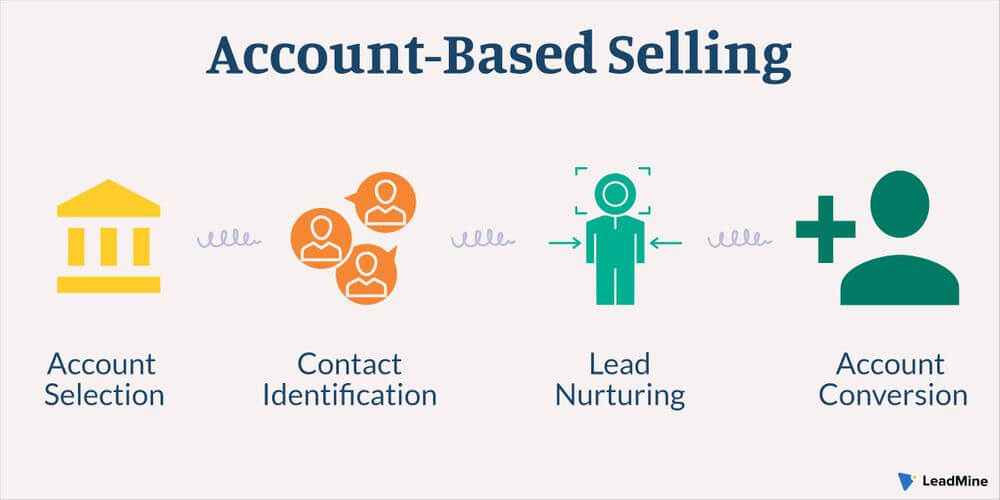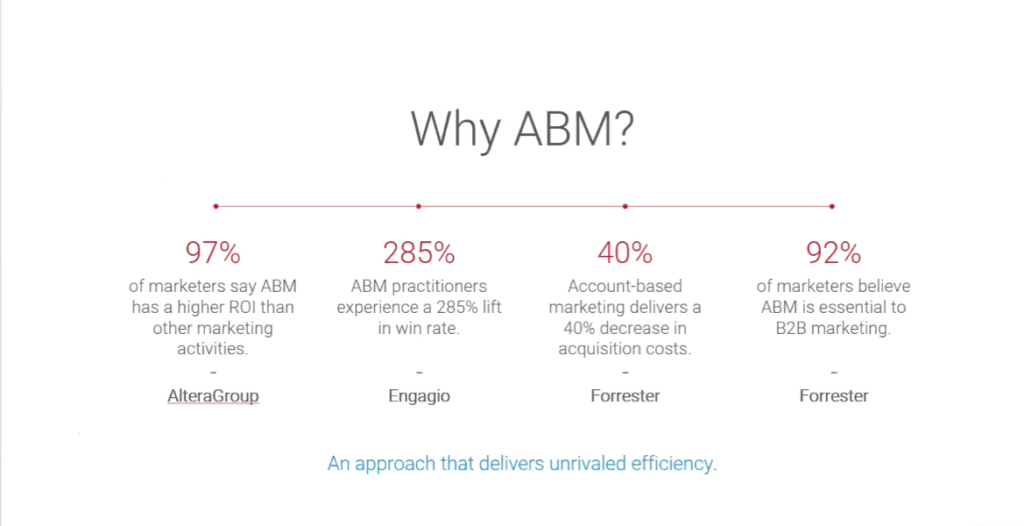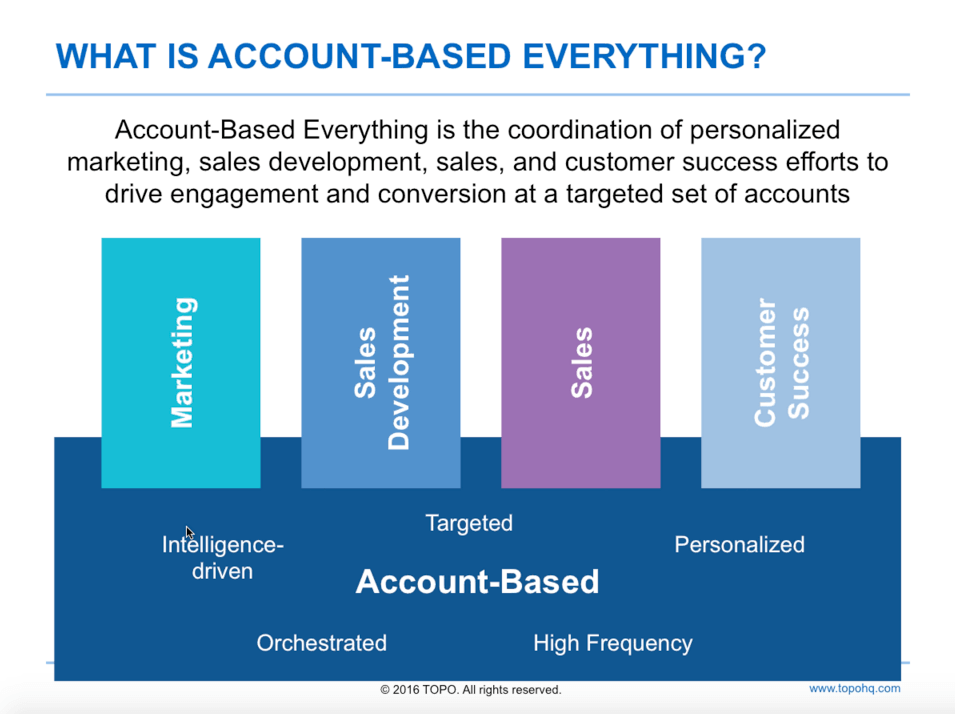Account-based Sales vs. Account-based Marketing

For many B2B companies, account-based marketing is one of the most effective ways to cultivate high-quality leads. However, your marketing system’s advantages can evaporate if you hand these leads off to a sales team that hasn’t fully adapted to an account-based strategy. The solution is to make sure they use a complementary approach: account-based sales.
Account-based marketing (ABM) has been around for a long time, but big data has ushered in a true renaissance for this marketing method. In 2021, 70% of marketers reported using an ABM strategy, an increase of 15% over the past year. The results of employing ABM are usually very good. 62% of marketers report that ABM has positively impacted their efforts. But when ABM isn’t succeeding, it’s often because sales and marketing aren’t working together in strong alignment.
Account-based sales (ABS) isn’t just a continuation of ABM. ABS chooses its targets differently and focuses on different metrics. Understanding how the account-based philosophy works in a sales context is the key to ensuring that your teams synergistically work together to generate new sales and strong customer loyalty.
In this post, we’ll go over the details that differentiate ABM and ABS, their benefits, and provide guidance on the best way to implement them together for optimal results.
What is Account-based Sales (ABS)?
It can be tempting to think that once marketing has generated a promising new lead account, all sales does is nudge them past the goalposts. ABM is a great way to set your sales team up for success, but they have to follow through with an approach that builds on marketing’s wins.
ABS is all about finding the best ways to turn the leads generated by ABM into sources of revenue. ABS works best when you break down any silos that separate sales and marketing, allowing the two teams to share data that informs the most effective selling tactics.

In a traditional sales approach, a sales representative might target a specific individual lead that marketing brought in. If that person changes jobs or loses interest, the deal in progress can fall apart. In ABS, your sales team identifies and targets all of the key decision-makers within the lead’s organization, tailoring their approach with personalized outreach and nurturing that speaks directly to their needs, desires, and pain points.
ABS isn’t for everyone. It’s a resource-intensive methodology that is not always cost-effective when your customers are small to medium-size businesses, if your average deal size isn’t very large, or if your customers typically make a one-time purchase (as opposed to multiple purchases over time or ongoing subscriptions).
What are the benefits of ABS?
According to more than half of B2B sales and marketing professionals, personalization boosts conversions and growth. ABS’s personalized approach is highly effective at getting leads to reply when you first reach out to them. It also helps you build trust with the individuals within the organization who will ultimately decide whether to purchase from you or not.
ABS really shines when it comes to customer loyalty and retention. The personalized, high-touch tactics that help you land the sale can continue through periods of onboarding and ongoing support, keeping you highly attuned to the customer’s long-term needs. It’s been shown that closely-aligned sales and marketing teams employing ABS can increase customer retention by up to 36%.
How is ABS measured?
The best way to measure the efficacy of your ABS efforts is to focus on the ultimate goal: revenue. The two of the most important KPIs to track are Customer Acquisition Costs (CAC), which tells you how much it costs for your ABS activities to bear fruit; and your Average Contract Value (ACV). It’s expected that CAC will go up under ABS, but you should see a commensurate increase in ACV that results in higher ROI.
For the repeat sellers and subscription services, it’s also essential to track Lifetime Value, which should tell you if the retention and loyalty benefits are manifesting as expected.
What is Account-based Marketing (ABM)?
Instead of creating content and messaging that casts a wide net for catching multiple leads that fit a target profile, the ABM approach treats every potential customer as a market of one. You identify the businesses that would be an ideal fit for your solution and market yourself directly to them.
As is the case with ABS, personalization is the key ingredient in ABM. It’s not enough to possess detailed facts about the target organization and its most important stakeholders. You also need to know exactly where they are in their buyer journey when reaching out to them, because timing is everything. A highly personalized message sent at the wrong time can be just as off-putting to a lead as a generic, scattershot marketing blast.
A robust ABM approach involves identifying the customer accounts you want to target, building detailed personas based on the information you have about them, developing highly relevant content that speaks to their areas of greatest concern, and engaging with your leads over their preferred channels.
What are the benefits of ABM?
One great thing about ABM is that it clarifies your marketing goals and the metrics that tell you whether or not you’re meeting them. This enhanced clarity makes it easier for you to show positive ROI due to specific marketing activities. 87% of ABM marketers report that ABM generates higher ROI than traditional marketing campaigns.

By bringing your sales and marketing teams into closer alignment and helping you allocate resources more efficiently, ABM can tighten up your sales cycles and put your sales team in the most advantageous position to execute an effective ABS strategy.
How is ABM measured?
ABM gives you many metrics to track, but the good news is that they can tell you a lot about how well your campaign is performing. Here are several of the most informative:
- Engagement rates – Are your leads really consuming your content and interacting with it?
- Email opens – Are the personalized messages you’re sending actually getting read?
- Click-through rates – Are your targeted digital ads and email CTAs getting clicks?
- Social media – Are you succeeding at making connections with your leads on their preferred communication platforms? Are they liking, commenting, and sharing?
- Content consumption – Which blog posts, videos, and articles are your leads spending the most time with?
- Pipeline velocity – Wre you closing deals faster under ABM?
The primary goal of ABM is to generate high-quality, high-value leads, so it’s fair to see lead generation as the ultimate metric that tells you whether or not it’s working. However, the bigger picture is that ABM should be feeding into sales wins and generating higher ROI.
Account-based Sales vs. Account-based Marketing
It might be better to think of ABM and ABS as two ends of a spectrum rather than two separate processes. Under ideal conditions, ABM should initiate contact with the target account and nurture it into a lead with personalized, relevant marketing messages. At the right moment, a seamless transition should occur, with sales taking over to engage directly with executives, managers, and other identified decision-makers within the lead organization.

ABM can declare “mission accomplished” once the deal goes through, but ABS is far from finished. Its long-term goal is to continue cultivating the customer relationship to increase loyalty and encourage additional or ongoing purchases. Working together, ABM and ABS create a powerful sales funnel.
How to Implement ABS and ABM Together
Many experts believe that the optimal approach is ABE—Account-Based Everything. ABE describes a model in which not only are sales and marketing in close alignment, but every department in the company—finance, customer service, the C-suite—is all-in on a comprehensive account-based sales and marketing strategy. This approach makes sense because customer service is key to building trust and loyalty, and executives can drive sales by building personal connections with their peers in the target organization.
Ultimately, the crucial factor in successfully implementing ABS and ABM is getting sales and marketing out of their respective silos. They must be encouraged to work together in close alignment, sharing knowledge and insights.

Also, remember that content isn’t just for marketers. Customized reports and workshops may be a significant investment, but they can pay off big when delivered to the right lead at the right moment. Post-sale, ABS teams need content that helps customers get the most value out of their new purchase and encourages them to stay loyal. Training sessions, user events, and feedback meetings are just a few examples of content that can boost customer satisfaction and long-term revenue after the initial deal is completed.
ABS + ABM = Optimal Results
When you hear about the benefits of ABM, it’s often implied—but not explicitly stated—that you need sales to meet the lead on their end with ABS. An abrupt transition from the high-touch approach of ABM to the old-school sales tactic of working leads in one-to-one isolation is unlikely to yield optimal results. By pairing ABM with an equally well-executed ABS strategy, you give yourself the best opportunity to land the high-value target accounts you’ve set your sights on.
The last thing to remember is that all of your detailed client knowledge, engaging content, and brilliant outreach plans will go to waste if your target is not in the right mindset for the messaging you’ve got queued up for them. A solution like Trendemon, which tracks how and when your leads are engaging with your content, can pinpoint precisely where they are in their buyer journey. This data gives you visibility into your lead’s thought process and makes it possible for you to serve content that converts at the moment when it will make the greatest impact.